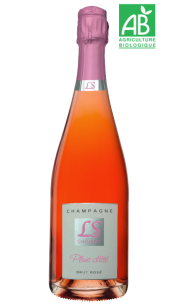Rose
Champagne Rose
Increasingly popular, rose champagne has something to seduce... Generally more fruity, with aromas of red fruits, it will go perfectly with an aperitif, white meat, or even certain desserts.
There are two types of rose in Champagne: rose d'assemblage and rose de saignée (more vinous, richer and of a brighter color than rosé d'assemblage).
Filters
What is a Rose champagne?
Notes of red fruits, delicacy, roundness... So many words that can describe what you feel when you taste a rose champagne. But, do you know how is it made ?
In reality, there are two ways to produce rose champagne:
The first way is to vinify two wines separately: a white and a red. These wines are then blended before foaming to give birth to the color and characteristic aromas of a rose. These champagnes which are the most produced are called blended rose.
The second way consists in allowing the must to macerate briefly (several hours) with the grapes skin. The pigments of the black grapes (in Champagne the Pinot Noir and the Pinot Meunier), will color the juices and bring unique aromatic touches. At the end of the maceration, the tank is "bled", that is to say emptied in order to separate the must from the skins. Rarer in Champagne, these Saignée rose are also more aromatic and often endowed with an intense pink color which varies according to the vintages.
What is the difference between a blended Rose and a Saignée rose?
By far the most common, blended rose is a champagne with a medium pink color. Its aromas are discreet on the red fruits and not very tannic due to the low proportion of red wine during its assembly (from 5 to 20%). Generally pale in color, blended rose are ideal for champagne lovers looking for a fresh, friendly cuvée with discreet aromas of red fruits.
Conversely, Saignée rose are more confidential. Their method of elaboration makes them more marked wines, whose intense color varies according to the years. Due to the direct contact of the juices with the skins, Saignée rose are more vinous and richer champagnes. The intensity of the color of Saignée rose makes them a safe bet for aperitifs with friends or family. They will particularly appeal to lovers of fresh, fruity and slightly tannic champagne.
Is Champagne Rose sweet?
Preconceived ideas about the color, more marked or not, can mislead you. A rose champagne is not necessarily sweet, it all depends on the dosage (the level of sugar present in the bottle). It is quite possible that a rose is as dry as an extra-brut champagne for example, don't be fooled by appearances...
How to choose your rose champagne?
It's hard to choose when you haven't tasted it yet... It's for this reason that our team has selected for you the best ros champagnes from all types of viticulture and from each of the Champagne vineyards. Our selection and the filters at your disposal will allow you to discover new champagnes from winegrowers with complete peace of mind. Whether you are a fan of Grand Cru rose or Brut rose champagne, our filters will make you enjoy the best Champagne bubbles.
Discover all our cuvées and do not hesitate to ask us for advice via the chat (bottom right of your screen), by email or directly by phone on +33 1 89 27 00 60 (9 a.m. to 6 p.m. Monday to Friday).













